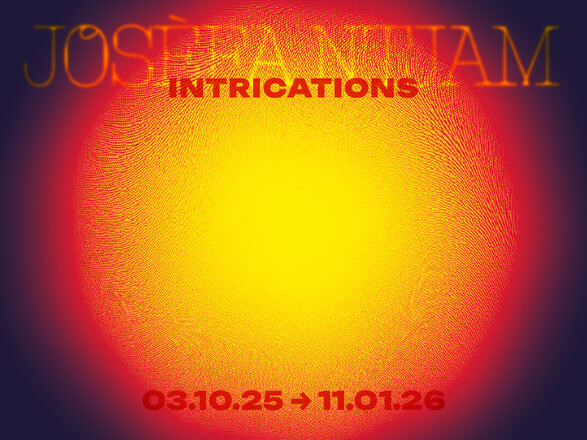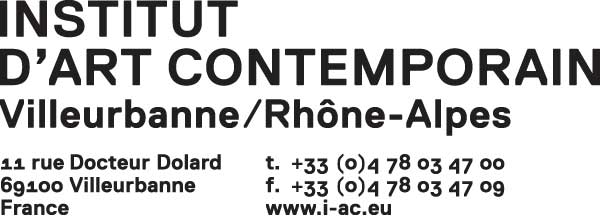A world resurfaces, fragment by fragment, in the slow rhythm of reconfiguring forms. For her most expansive exhibition to date, Josèfa Ntjam transforms the 1200 m² of the Institut d’art contemporain and the display windows of the Gare Part-Dieu metro station into a sensory, political, and mythological drift. A terrain where everything wavers: textures, voices, memories... Here, form follows the fracture, and legend beats to the rhythm of an underground heart.
The title, INTRICATIONS [Entanglements], comes from quantum physics. It refers to this: that two particles, even when separated by light-years, can continue to vibrate in unison. This thread connecting things that seemed entirely apart — skin and metal, revolt and plant life, a scream and a comet — runs through the whole journey of the exhibition.
The title, INTRICATIONS [Entanglements], comes from quantum physics. It refers to this: that two particles, even when separated by light-years, can continue to vibrate in unison. This thread connecting things that seemed entirely apart — skin and metal, revolt and plant life, a scream and a comet — runs through the whole journey of the exhibition.
INTRICATIONS [Entanglements] unfolds like an expanding fiction. One enters as into a forest of images, a threshold of matter: dense, nearly impenetrable. Marthe Ekemeyong Moumié, Élisabeth Djouka, and Mafory Bangoura1 stand watch here, guardians of the stories that are about to be told. In their wake, Persona, Marthe and Saturna — shifting avatars, embodied without being assigned — are crossed by voices, bodies, and data. They never speaks from a single “I” but from a network: of Black memory, matriarchal lineages, queer identities, and suppressed histories. Their voice are refracted, doubled, as if to show that all speech from the margins is layered.
Brought together, these figures – real or imagined – intertwine with Dogon2, Fang3, and Bassa4 cosmogonies, as well as diasporic myths born of exile. A teeming maquis as much as a fantasized biotope, the exhibition space shelters its own speculative mythology, populated with chimeric figures and biological entities. These latter, chosen for their structural or biological capacities, embody a discreet strength: that of building in the shadows while endlessly regenerating themselves. Interlaced, the whole rubs and resonates to produce new images, fugitives in the making. What’s at stake is a poetics of flight — not as abandonment, but as strategy, as the science of escape and displacement. Clandestine, aquatic, shifting, fiction here is resistance.
To compose it, Josèfa Ntjam draws from everything: cardboard and bio-resin, video game engines and artificial intelligence, sand, metal, and song. She experiments. She melds. She assembles as one invents worlds. And at the heart of this world: a sound installation — the artist’s first of its kind — conceived especially for the IAC. A sensitive center of gravity, it acts like a beating heart, an echo chamber that absorbs and redistributes the vibrations of the journey.
Around it, the cosmos resonates. A ground for speculation, it serves as a shelter for voices cast out by dominant narratives and for dreams reality has not yet permitted. In INTRICATIONS [Entanglements], the legend is alive. It does not illuminate; it murmurs, it twists, it draws us in. And perhaps with it, our gaze, too, begins to reconfigure. Josèfa Ntjam places herself in the lineage of those who think with fiction — not to flee reality, but to reveal its invisible folds. With Sun Ra, Octavia Butler, Drexciya, or Kodwo Eshun5, she dreams — yes — but dreams with teeth, with roots, with the sea.
--------------------------------------
GARE PART-DIEU — vivier merle METRO STATION
At the Gare Part-Dieu metro station, three display windows host an extension of the INTRICATIONS exhibition, becoming fragments of a larger narrative—outposts of an expanding imaginary.
The first two windows, echoing the opening gallery of the Institut d’art contemporain, take the form of dioramas. Once again, biological entities, mythological figures, and contemporary elements compose a floating topography that resonates with the layered logic central to Josèfa Ntjam’s practice. These windows do not signal—they drift. They turn waiting into listening, and the commuter into a fleeting witness.
The third window gathers the posters of the four video works projected at the Institut d’art contemporain—Dislocations, Myceaqua Vitae, matter gone wild, swell of spæc(i)es. Created in collaboration with Sean Hart, they are conceived as fragments of worlds, portals into decentered temporalities. Here too, each image is designed as a sensitive organ of the project—a surface to pass through rather than a mere visual.
Thus, even in the heart of everyday transit, INTRICATIONS continues to resonate. It seeps into the ordinary, slips between connections, and invites a more porous kind of attention. Because here too, between tiles and metal, something is breathing.
Brought together, these figures – real or imagined – intertwine with Dogon2, Fang3, and Bassa4 cosmogonies, as well as diasporic myths born of exile. A teeming maquis as much as a fantasized biotope, the exhibition space shelters its own speculative mythology, populated with chimeric figures and biological entities. These latter, chosen for their structural or biological capacities, embody a discreet strength: that of building in the shadows while endlessly regenerating themselves. Interlaced, the whole rubs and resonates to produce new images, fugitives in the making. What’s at stake is a poetics of flight — not as abandonment, but as strategy, as the science of escape and displacement. Clandestine, aquatic, shifting, fiction here is resistance.
To compose it, Josèfa Ntjam draws from everything: cardboard and bio-resin, video game engines and artificial intelligence, sand, metal, and song. She experiments. She melds. She assembles as one invents worlds. And at the heart of this world: a sound installation — the artist’s first of its kind — conceived especially for the IAC. A sensitive center of gravity, it acts like a beating heart, an echo chamber that absorbs and redistributes the vibrations of the journey.
Around it, the cosmos resonates. A ground for speculation, it serves as a shelter for voices cast out by dominant narratives and for dreams reality has not yet permitted. In INTRICATIONS [Entanglements], the legend is alive. It does not illuminate; it murmurs, it twists, it draws us in. And perhaps with it, our gaze, too, begins to reconfigure. Josèfa Ntjam places herself in the lineage of those who think with fiction — not to flee reality, but to reveal its invisible folds. With Sun Ra, Octavia Butler, Drexciya, or Kodwo Eshun5, she dreams — yes — but dreams with teeth, with roots, with the sea.
--------------------------------------
GARE PART-DIEU — vivier merle METRO STATION
From September 16, 2025 to FEBRUARY 16, 2026
At the Gare Part-Dieu metro station, three display windows host an extension of the INTRICATIONS exhibition, becoming fragments of a larger narrative—outposts of an expanding imaginary.
The first two windows, echoing the opening gallery of the Institut d’art contemporain, take the form of dioramas. Once again, biological entities, mythological figures, and contemporary elements compose a floating topography that resonates with the layered logic central to Josèfa Ntjam’s practice. These windows do not signal—they drift. They turn waiting into listening, and the commuter into a fleeting witness.
The third window gathers the posters of the four video works projected at the Institut d’art contemporain—Dislocations, Myceaqua Vitae, matter gone wild, swell of spæc(i)es. Created in collaboration with Sean Hart, they are conceived as fragments of worlds, portals into decentered temporalities. Here too, each image is designed as a sensitive organ of the project—a surface to pass through rather than a mere visual.
Thus, even in the heart of everyday transit, INTRICATIONS continues to resonate. It seeps into the ordinary, slips between connections, and invites a more porous kind of attention. Because here too, between tiles and metal, something is breathing.
1. Marthe Ekemeyong Moumié, a Cameroonian independence activist, writer, and political prisoner, dedicated her life to the anti-colonial struggle. Élisabeth Djouka, a healer and traditional Bassa chief, was arrested for her role in resistance movements; she embodied both ancestral knowledge and political voice. Mafory Bangoura, a key figure in Guinea’s fight for independence, worked toward the emancipation of women and their organization in the public sphere. All three are anchoring figures—powers of care, revolt, and transmission.
2. The Dogon people, settled along the cliffs of Bandiagara in Mali, uphold a complex cosmogony intertwining origin stories, aquatic figures such as the Nommo, and symbolic knowledge passed down orally. Their cyclical worldview unites spirituality, speech, and matter.
3. The Fang, a Bantu people from Gabon, Equatorial Guinea, and southern Cameroon, transmit through the Mvett an initiatory narrative that weaves together philosophy, history, and spirituality, linking the living, ancestors, and invisible forces through struggle and transformation.
4. The Bassa, mainly located in Cameroon, ground their oral tradition in song, poetry, and initiatory tales, including the Mvett, which recounts ancestral memory, migrations, and spiritual knowledge. Their cosmology resonates through a constant dialogue between visible and invisible worlds, carried by voice, breath, and rhythm.
5. Sun Ra, Octavia Butler, Drexciya, and Kodwo Eshun are major figures of Afrofuturism. Musician Sun Ra developed a sonic cosmology blending jazz and science fiction to imagine emancipated Black futures. Writer Octavia Butler explored transformation, marginal identities, and transmission in her narratives. The techno duo Drexciya created an aquatic mythology born from the transatlantic slave trade. Theorist Kodwo Eshun conceives fiction as a critical and speculative tool for reconfiguring diasporic narratives.
2. The Dogon people, settled along the cliffs of Bandiagara in Mali, uphold a complex cosmogony intertwining origin stories, aquatic figures such as the Nommo, and symbolic knowledge passed down orally. Their cyclical worldview unites spirituality, speech, and matter.
3. The Fang, a Bantu people from Gabon, Equatorial Guinea, and southern Cameroon, transmit through the Mvett an initiatory narrative that weaves together philosophy, history, and spirituality, linking the living, ancestors, and invisible forces through struggle and transformation.
4. The Bassa, mainly located in Cameroon, ground their oral tradition in song, poetry, and initiatory tales, including the Mvett, which recounts ancestral memory, migrations, and spiritual knowledge. Their cosmology resonates through a constant dialogue between visible and invisible worlds, carried by voice, breath, and rhythm.
5. Sun Ra, Octavia Butler, Drexciya, and Kodwo Eshun are major figures of Afrofuturism. Musician Sun Ra developed a sonic cosmology blending jazz and science fiction to imagine emancipated Black futures. Writer Octavia Butler explored transformation, marginal identities, and transmission in her narratives. The techno duo Drexciya created an aquatic mythology born from the transatlantic slave trade. Theorist Kodwo Eshun conceives fiction as a critical and speculative tool for reconfiguring diasporic narratives.


